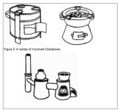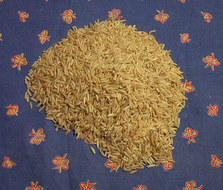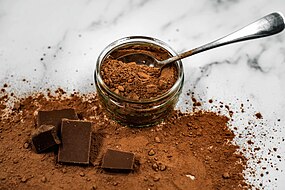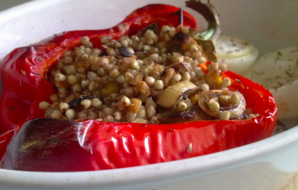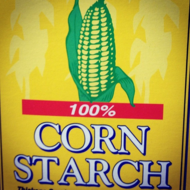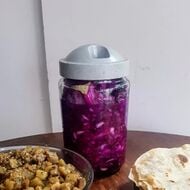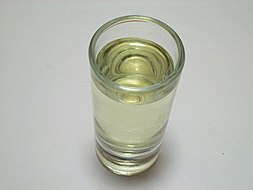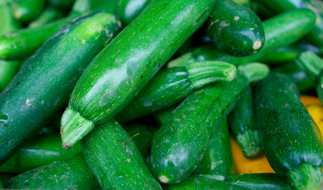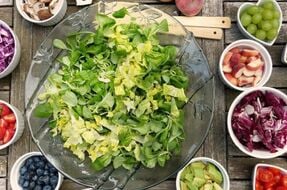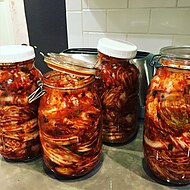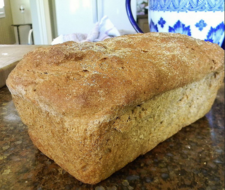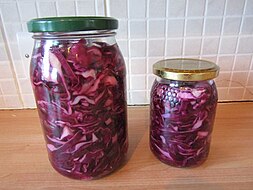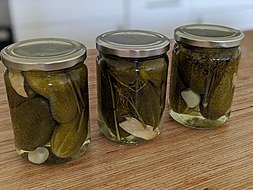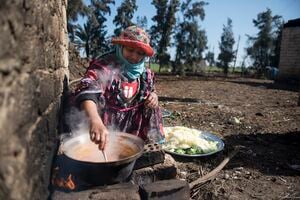
Cooking is the process of preparing food, often with the use of heat.
It takes a special part in sustainability when it comes to how food is prepared. For this, there are different cooking devices that can reduce your environmental impact such as solar cookers and rocket stoves. When it comes to what ingredients are used, meat is probably the most harmful for the environment for several reasons (including methane emissions, resources use and energy efficiency). This is why any ecologic diet should take this into consideration.
There are several cooking techniques; the application of heat is generally a necessity as it kills any microbial pathogens that may be present in the food. Only in specific cases (very fresh food), heat may not be required.
At the end of this page you will find several recipes to try out everything you've learnt.
Sustainable cooking devices[edit | edit source]
Solar cooker[edit | edit source]

Several engineers and DIY enthusiasts have designed literally hundreds of different types of solar cookers; from simple designs like the solar bowling oven to more complicate ones like the parabolic basket and tin can solar cooker. This expansive variety of options makes it difficult to standardize and evaluate solar cookers, however some critical factors must be met for a design to be successful, some of which are listed below: Cost - must be cheap enough to be viable for implementation into rural areas.
- Convenience - can be built by readily available local materials in a short period of time, as well as being light-weight.SOL
- Safety - heated area must be well protected and no parts should be jutting out.
- Efficiency - how long will it take to cook the food?
- Wind resistance - must be sturdy enough to not be affected by light to moderate winds.
- Heating capacity - sufficient heating capacity based on it's use (water pasteurization vs. cooking food).
- Durability - repairs should be infrequent and easily performed.
- Simplicity of instructions.
The requirements for solar cooking are very simple. You must be able to place the solar cooker in a location that gets sun for several hours and be protected from strong wind. Solar cookers, obviously do not work at night or on very cloudy days. The sunlight is absorbed on dark surfaces that heat up. Food cooks best in dark, shallow, thin metal pots with dark, tight-fitting lids to hold in heat and moisture. To retain the heat created when the black pot absorbs the suns rays some form of transparent cover is needed. This can be as simple as a clear plastic bag or as complicated as evacuated multiple layers of glass. One method to speed the cooking process is to use reflectors to increase the concentration of sunlight on your collector.
Rocket stove[edit | edit source]
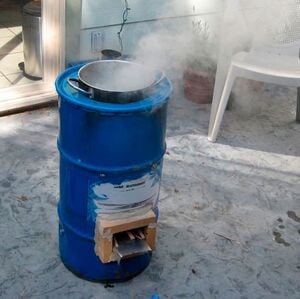
A rocket stove is a variety of wood-burning cooking stove with a higher efficiency than other types of traditional ovens due to a better insulation and a better combustion process. They function under a similar principle as rocket stove mass heaters. Most rocket stoves are easy to build, and can be made with low-cost materials (the CCAT rocket stove for instance, costs only USD$84.02).
There is a wide variety of designs amongst stoves included in the 'Rocket Stove' family, but they have the following characteristic features:
- The combustion chamber and interior stove parts are as insulative and lightweight as possible. Heavy materials in contact with hot flue gases absorb heat that could have been used for cooking.
- The combustion chamber is insulated in order to keep the fire hot (above 650 ºC) to burn the wood more completely, thereby reducing smoke (which is fuel that has not burnt completely).
- The combustion chamber is usually in the shape of an elbow or letter 'L', so that wood is placed under a short internal chimney as it is fed into the stove.
- Wood is burned at the tips and is pushed in towards the fire as it burns. Feeding fuel at the correct rate creates cleaner combustion, reducing smoke.
Improved solid biofuel stoves[edit | edit source]
- This page refers to stoves using a fuel, usually solid. For solar versions, see Solar cooking
Improved solid biofuel stoves, smokeless stoves or wood conserving stoves are solid biofuel stoves designed to be at least 10% more fuel efficient than regular solid biofuel stoves or reduce the health problems associated with traditional cooking fires. They are widely used in developing countries and are often very simple designs. These designs, when they work as intended, don't fill the home with harmful smoke (through more efficient burning to reduce smoke, and a chimney or venting to remove that smoke), and use less fuel. Several designs have been developed depending on the local materials available, environmental conditions, and community needs.
-
fig 1: A selection of improved cook stoves
-
fig 1a: Open Fire Cookstove
-
fig 1b: Patsari improved cookstove made of bricks and mortar and ruble filling
-
fig c: Lorena cookstove made of rammed earth
-
fig d: Women can design and Manufacture improved cook stoves. ©Simon Ekless/Practical Action
Solar dehydrator[edit | edit source]
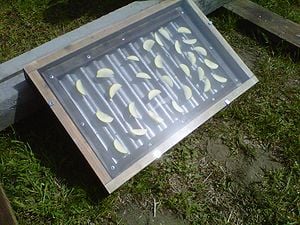
A solar dehydrator (or solar drier) allows the user to preserve food without the energy cost or pollution associated with other drying techniques.
Agricultural and other products have been dried by the sun and wind in the open air for thousands of years. The purpose is either to preserve them for later use, as is the case with food; or as an integral part of the production process, as with timber, tobacco and laundering. In industrialised regions and sectors, open air-drying has now been largely replaced by mechanised dryers, with boilers to heat incoming air, and fans to force it through at a high rate. Mechanised drying is faster than open-air drying, uses much less land and usually gives a better quality product. But the equipment is expensive and requires substantial quantities of fuel or electricity to operate.
'Solar drying' in the context of this technical brief, refers to methods of using the sun's energy for drying, but excludes open air 'sun drying'. The justification for solar dryers is that they may be more effective than sun drying, but have lower operating costs than mechanised dryers. A number of designs are proven technically and while none are yet in widespread use, there is still optimism about their potential.
Ecologic diet[edit | edit source]
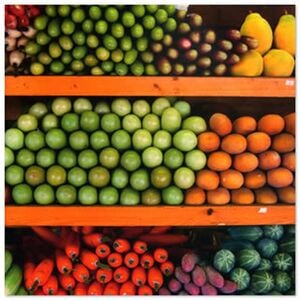
Reducing your meat consumption can not only improve your health,[1] make you live longer,[2] be in line with your ethics, and many more benefits; it can also help solving environmental issues such as deforestation and climate change. This is mainly because meat production requires a lot of land for growing animal feed. Meat production industry is one of the most harmful industries for the environment as it causes a massive amount of greenhouse gas emissions and wastes large amounts of water and grain.
Even though it might be tough, reducing meat consumption will lower the demand for meat, in turn reducing the environmental impact of this industry. Producing plant-based foods generally results in fewer greenhouse gas emissions and requires less energy, land, and water. This is why eating more vegetables, fruits, whole grains, legumes, nuts, and seeds, and less meat and dairy, can significantly lower your environmental impact.[3]
In addition, you can reduce your impact on the environment by buying local. Buying local products and other goods not only reduces some of the energy consumption involved in the transport of food, it also supports local farmers[4] and growers in your community.[5]
Techniques[edit | edit source]
Baking[edit | edit source]
Baking - the technique of prolonged cooking of food by dry heat acting by convection, normally in an oven, but can also be done in hot ashes or on hot stones.
- Blind Baking – baking pastry before adding a filling.[6]
Boiling[edit | edit source]
Boiling – the rapid vaporization of a liquid, which occurs when a liquid is heated to its boiling point, the temperature at which the vapor pressure of the liquid is equal to the pressure exerted on the liquid by the surrounding environmental pressure.
- Blanching – cooking technique which food substance, usually a vegetable or fruit, is plunged into boiling water, removed after a brief, timed interval, and finally plunged into iced water or placed under cold running water (shocked) to halt the cooking process.c
- Braising – combination cooking method using both moist and dry heat; typically the food is first seared at a high temperature and then finished in a covered pot with a variable amount of liquid, resulting in a particular flavour.
- Coddling – food is heated in water kept just below the boiling point.
- Infusion –
- Pressure cooking – cooking in a sealed vessel that does not permit air or liquids to escape below a preset pressure, which allows the liquid in the pot to rise to a higher temperature before boiling.
- Simmering – foods are cooked in hot liquids kept at or just below the boiling point of water,[7] but higher than poaching temperature.
- Poaching – process of gently simmering food in liquid, generally milk, stock or wine.
- Steaming – boiling water continuously so it vaporizes into steam and carries heat to the food being steamed, thus cooking the food.
- Double steaming – Chinese cooking technique in which food is covered with water and put in a covered ceramic jar and the jar is then steamed for several hours.
- Steeping – saturation of a food (such as an herb) in a liquid solvent to extract a soluble ingredient into the solvent. E.g., a cup of tea is made by steeping tea leaves in a cup of hot water.
- Stewing – food is cooked in liquid and served in the resultant gravy.
- Vacuum flask cooking –
Broiling[edit | edit source]
Grilling – a form of cooking that involves dry heat applied to the surface of food, commonly from above or below.
Frying[edit | edit source]
Frying – cooking food in oil or another fat, a technique that originated in ancient Egypt around 2500 BC.[8]
- Deep frying – food is submerged in hot oil or fat. This is normally performed with a deep fryer or chip pan.
- Hot salt frying –
- Hot sand frying –
- Pan frying – cooking food in a pan using a small amount of cooking oil or fat as a heat transfer agent and to keep the food from sticking.
- Pressure frying –
- Sautéing –
- Stir frying –
Microwaving[edit | edit source]
Microwave oven – type of oven that heats foods quickly and efficiently using microwaves, but, unlike conventional ovens, does not brown or bake food. This makes them unsuitable for cooking certain foods, or to achieve certain culinary effects. Additional kinds of heat sources can be added to microwave packaging, or into combination microwave ovens, to add these additional effects.
Roasting[edit | edit source]
Roasting – cooking method that uses dry heat, whether an open flame, oven, or other heat source. Roasting usually causes caramelization or Maillard browning of the surface of the food, which is considered by some as a flavor enhancement.
- Barbecuing – method of cooking meat, poultry and occasionally fish with the heat and hot smoke of a fire, smoking wood, or hot coals of charcoal.
- Grilling – applying dry heat to the surface of food, by cooking it on a grill, a grill pan, or griddle.
- Rotisserie – meat is skewered on a spit - a long solid rod used to hold food while it is being cooked over a fire in a fireplace or over a campfire, or while being roasted in an oven.
- Searing – technique used in grilling, baking, braising, roasting, sautéing, etc., in which the surface of the food (usually meat, poultry or fish) is cooked at high temperature so a caramelized crust forms.
Smoking[edit | edit source]
Smoking – the process of flavoring, cooking, or preserving food by exposing it to the smoke from burning or smoldering plant materials, most often wood.
Chemical techniques[edit | edit source]
- Brining –
- Ceviche –
- Drying –
- Fermentation –
- Marinating –
- Pickling –
- Salting –
- Seasoning –
- Smoking –
- Souring –
- Sprouting –
- Sugaring –
Mechanical techniques[edit | edit source]
- Basting –
- Cutting
- Chopping
- Dicing –
- Grating –
- Julienning –
- Mincing –
- Peeling –
- Shaving –
- Kneading –
- Milling –
- Mixing –
- Blending –
Recipes[edit | edit source]
Here you will find delicious cooking ideas that involve reducing your meat consumption and environmental impact.
References[edit | edit source]
- ↑ https://www.mayoclinic.org/healthy-lifestyle/nutrition-and-healthy-eating/in-depth/meatless-meals/art-20048193#:~:text=The%20health%20factor,heart%20disease%20than%20nonvegetarians%20do.
- ↑ https://edition.cnn.com/2016/08/01/health/meat-eaters-risk-of-death-plant-protein/index.html
- ↑ https://www.un.org/node/143154#plant-based-food
- ↑ https://greenlivingguy.com/2021/02/organic-herbal-farming-and-its-benefit-to-the-environment/
- ↑ https://greenlivingguy.com/2020/04/5-great-tips-to-make-your-home-eco-friendly/
- ↑ "How to blind bake". Tesco realfood. Retrieved 30 December 2011.
- ↑ Simmer definition from About.com - Culinary arts. Retrieved May 2009.
- ↑ Tannahill, Reay. (1995). Food in History. Three Rivers Press. p. 75
